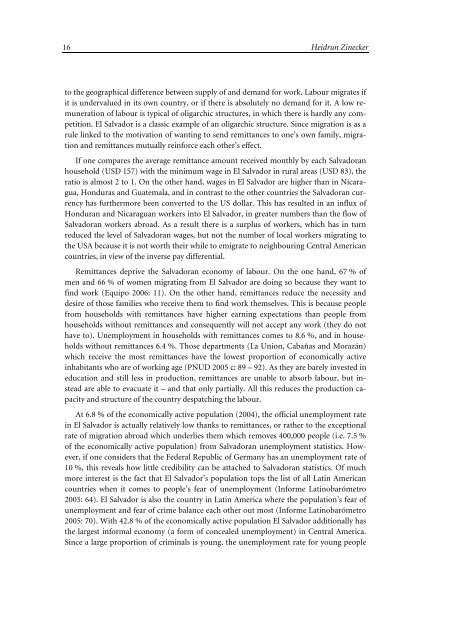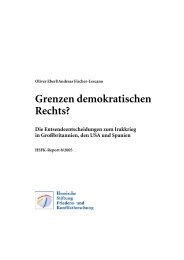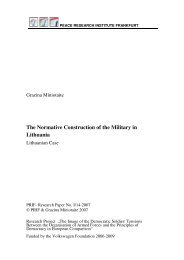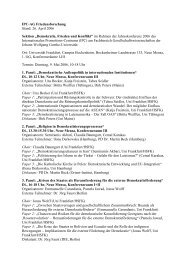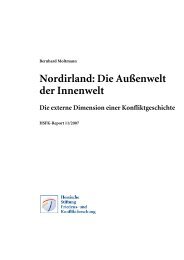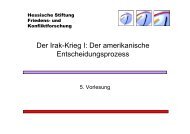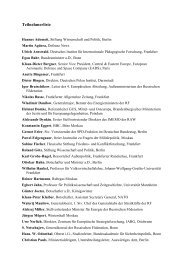From Exodus to Exitus Causes of post-war violence in El ... - eDoc
From Exodus to Exitus Causes of post-war violence in El ... - eDoc
From Exodus to Exitus Causes of post-war violence in El ... - eDoc
You also want an ePaper? Increase the reach of your titles
YUMPU automatically turns print PDFs into web optimized ePapers that Google loves.
16 Heidrun Z<strong>in</strong>ecker<br />
<strong>to</strong> the geographical difference between supply <strong>of</strong> and demand for work. Labour migrates if<br />
it is undervalued <strong>in</strong> its own country, or if there is absolutely no demand for it. A low remuneration<br />
<strong>of</strong> labour is typical <strong>of</strong> oligarchic structures, <strong>in</strong> which there is hardly any competition.<br />
<strong>El</strong> Salvador is a classic example <strong>of</strong> an oligarchic structure. S<strong>in</strong>ce migration is as a<br />
rule l<strong>in</strong>ked <strong>to</strong> the motivation <strong>of</strong> want<strong>in</strong>g <strong>to</strong> send remittances <strong>to</strong> one’s own family, migration<br />
and remittances mutually re<strong>in</strong>force each other’s effect.<br />
If one compares the average remittance amount received monthly by each Salvadoran<br />
household (USD 157) with the m<strong>in</strong>imum wage <strong>in</strong> <strong>El</strong> Salvador <strong>in</strong> rural areas (USD 83), the<br />
ratio is almost 2 <strong>to</strong> 1. On the other hand, wages <strong>in</strong> <strong>El</strong> Salvador are higher than <strong>in</strong> Nicaragua,<br />
Honduras and Guatemala, and <strong>in</strong> contrast <strong>to</strong> the other countries the Salvadoran currency<br />
has furthermore been converted <strong>to</strong> the US dollar. This has resulted <strong>in</strong> an <strong>in</strong>flux <strong>of</strong><br />
Honduran and Nicaraguan workers <strong>in</strong><strong>to</strong> <strong>El</strong> Salvador, <strong>in</strong> greater numbers than the flow <strong>of</strong><br />
Salvadoran workers abroad. As a result there is a surplus <strong>of</strong> workers, which has <strong>in</strong> turn<br />
reduced the level <strong>of</strong> Salvadoran wages, but not the number <strong>of</strong> local workers migrat<strong>in</strong>g <strong>to</strong><br />
the USA because it is not worth their while <strong>to</strong> emigrate <strong>to</strong> neighbour<strong>in</strong>g Central American<br />
countries, <strong>in</strong> view <strong>of</strong> the <strong>in</strong>verse pay differential.<br />
Remittances deprive the Salvadoran economy <strong>of</strong> labour. On the one hand, 67 % <strong>of</strong><br />
men and 66 % <strong>of</strong> women migrat<strong>in</strong>g from <strong>El</strong> Salvador are do<strong>in</strong>g so because they want <strong>to</strong><br />
f<strong>in</strong>d work (Equipo 2006: 11). On the other hand, remittances reduce the necessity and<br />
desire <strong>of</strong> those families who receive them <strong>to</strong> f<strong>in</strong>d work themselves. This is because people<br />
from households with remittances have higher earn<strong>in</strong>g expectations than people from<br />
households without remittances and consequently will not accept any work (they do not<br />
have <strong>to</strong>). Unemployment <strong>in</strong> households with remittances comes <strong>to</strong> 8.6 %, and <strong>in</strong> households<br />
without remittances 6.4 %. Those departments (La Union, Cabañas and Morazán)<br />
which receive the most remittances have the lowest proportion <strong>of</strong> economically active<br />
<strong>in</strong>habitants who are <strong>of</strong> work<strong>in</strong>g age (PNUD 2005 c: 89 – 92). As they are barely <strong>in</strong>vested <strong>in</strong><br />
education and still less <strong>in</strong> production, remittances are unable <strong>to</strong> absorb labour, but <strong>in</strong>stead<br />
are able <strong>to</strong> evacuate it – and that only partially. All this reduces the production capacity<br />
and structure <strong>of</strong> the country despatch<strong>in</strong>g the labour.<br />
At 6.8 % <strong>of</strong> the economically active population (2004), the <strong>of</strong>ficial unemployment rate<br />
<strong>in</strong> <strong>El</strong> Salvador is actually relatively low thanks <strong>to</strong> remittances, or rather <strong>to</strong> the exceptional<br />
rate <strong>of</strong> migration abroad which underlies them which removes 400,000 people (i.e. 7.5 %<br />
<strong>of</strong> the economically active population) from Salvadoran unemployment statistics. However,<br />
if one considers that the Federal Republic <strong>of</strong> Germany has an unemployment rate <strong>of</strong><br />
10 %, this reveals how little credibility can be attached <strong>to</strong> Salvadoran statistics. Of much<br />
more <strong>in</strong>terest is the fact that <strong>El</strong> Salvador’s population <strong>to</strong>ps the list <strong>of</strong> all Lat<strong>in</strong> American<br />
countries when it comes <strong>to</strong> people’s fear <strong>of</strong> unemployment (Informe Lat<strong>in</strong>obarómetro<br />
2005: 64). <strong>El</strong> Salvador is also the country <strong>in</strong> Lat<strong>in</strong> America where the population’s fear <strong>of</strong><br />
unemployment and fear <strong>of</strong> crime balance each other out most (Informe Lat<strong>in</strong>obarómetro<br />
2005: 70). With 42.8 % <strong>of</strong> the economically active population <strong>El</strong> Salvador additionally has<br />
the largest <strong>in</strong>formal economy (a form <strong>of</strong> concealed unemployment) <strong>in</strong> Central America.<br />
S<strong>in</strong>ce a large proportion <strong>of</strong> crim<strong>in</strong>als is young, the unemployment rate for young people


